The Automated Window Blinds Market is estimated to be valued at USD 1.8 billion in 2025 and is projected to reach USD 2.9 billion by 2035, registering a compound annual growth rate (CAGR) of 4.5% over the forecast period. During the early adoption phase (2020–2024), the market expanded from USD 1.5 billion to USD 1.8 billion as tech-savvy homeowners and commercial developers began integrating automated blinds for convenience, energy efficiency, and smart home compatibility. Adoption was driven by early adopters valuing remote control, automated scheduling, and integration with home automation systems. However, high costs, limited awareness, and concerns around installation complexity constrained faster market penetration. From 2025 to 2030, the market enters a scaling phase, with revenues rising from USD 1.8 billion to approximately USD 2.3 billion. Wider adoption was fueled by falling product costs, increasing smart home adoption, and improved interoperability with IoT ecosystems.
Rising demand in commercial and residential real estate projects, combined with regulatory incentives for energy-efficient buildings, accelerated the deployment of automated window blinds. Between 2030 and 2035, the market transitions into consolidation, reaching USD 2.9 billion by 2035. Leading suppliers strengthened their positions through product standardization, strategic partnerships, and incremental innovations in automation and energy management. Market growth stabilized as adoption became mainstream, reflecting a mature, competitive, and technologically advanced automated blinds landscape.
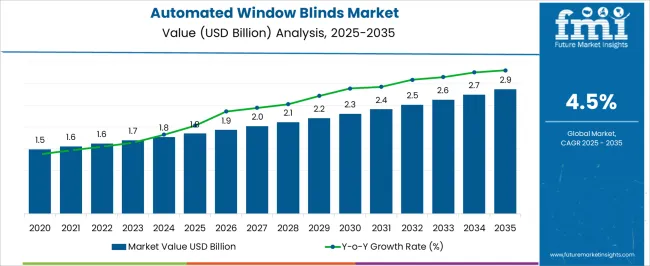
| Metric | Value |
|---|---|
| Automated Window Blinds Market Estimated Value in (2025 E) | USD 1.8 billion |
| Automated Window Blinds Market Forecast Value in (2035 F) | USD 2.9 billion |
| Forecast CAGR (2025 to 2035) | 4.5% |
The automated window blinds market is witnessing accelerated growth, supported by the increasing integration of smart home solutions and heightened demand for energy-efficient living environments. Urbanization, rising disposable income, and consumer inclination toward comfort and automation are driving market expansion across both residential and commercial applications.
Government initiatives promoting green buildings and sustainable construction are further influencing adoption, particularly where automated blinds contribute to thermal insulation and daylight regulation. Industry participants are investing in sensor-enabled and voice-integrated technologies to enhance user experience and system interoperability with smart ecosystems.
The future growth trajectory is likely to benefit from expanding real estate developments, retrofitting trends in older buildings, and growing awareness of glare reduction and indoor air quality optimization.
The automated window blinds market is segmented by product type, operation, material, installation, end use, distribution channel, and geographic regions. The automated window blinds market is divided by product type into Horizontal, Vertical, Roman, Roll Up, and Others (PVC, zebra, curtain). In terms of operation, the automated window blinds market is classified into fully automatic and Semi-automatic. The automated window blinds market is segmented into Aluminium, Wooden, PVC, and Others (vinyl, metal). The automated window blinds market is segmented into New and Retrofit. The automated window blinds market is segmented by end use into Home, Office, Restaurants and hotels, Hospitals & nursing homes, Schools and universities, and Others. The distribution channel of the automated window blinds market is segmented into Offline and Online. Regionally, the automated window blinds industry is classified into North America, Latin America, Western Europe, Eastern Europe, Balkan & Baltic Countries, Russia & Belarus, Central Asia, East Asia, South Asia & Pacific, and the Middle East & Africa.
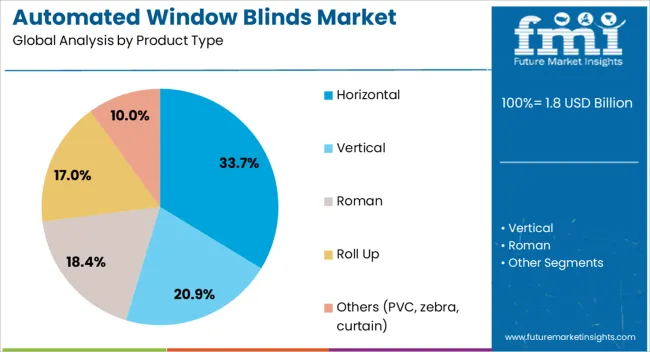
Horizontal automated blinds are projected to hold 33.70% of the total market share in 2025, making them the leading product type. This position is being supported by their versatility, clean design aesthetics, and compatibility with a wide range of window formats in both residential and commercial structures.
The ability to offer precise light control, better privacy options, and seamless integration with architectural themes has strengthened their market preference. Horizontal blinds are also easier to motorize and integrate with automation systems, making them a popular choice for developers and interior designers.
Their adaptability to both small and large window frames further enhances their appeal in urban and space-optimized construction layouts.
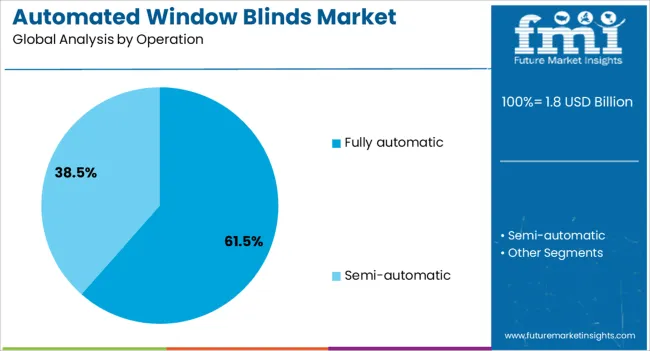
Fully automatic systems are expected to command 61.50% of the market share by 2025, establishing themselves as the dominant operation mode. Their growth is being fueled by advancements in AI and IoT technologies, which have enabled the integration of programmable timers, occupancy sensors, and remote app controls.
Consumers are increasingly seeking convenience and energy efficiency, which fully automatic systems deliver by dynamically adjusting to indoor lighting and temperature needs. In commercial buildings, automated operation contributes to LEED certification points and supports compliance with energy regulations.
As the cost of automation continues to decline and compatibility with smart home platforms improves, fully automatic systems are expected to become the default installation choice across premium and mid-range construction projects.
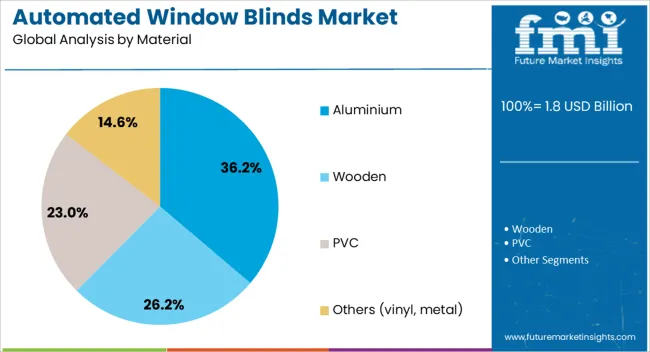
Aluminium blinds are forecast to account for 36.20% of the total market revenue in 2025, positioning them as the most preferred material segment. Their popularity is being driven by durability, low maintenance, and high recyclability, making them ideal for long-term use in varied climates.
Aluminium offers excellent heat reflectivity, helping to maintain indoor thermal comfort and reduce HVAC loads. It is also lightweight yet structurally stable, which aids in smoother motorized operation.
In addition, aluminium’s resistance to moisture, corrosion, and fading makes it suitable for both residential and commercial settings, including kitchens, bathrooms, and high-humidity zones. As sustainability gains traction in building materials procurement, aluminium’s eco-friendly profile further strengthens its demand in the automated blinds market.
The automated window blinds market is expanding as residential and commercial buildings increasingly adopt smart, user-friendly shading solutions. These systems offer convenience, energy management, and enhanced privacy, integrating with home automation platforms. Rising consumer demand for comfort, aesthetics, and remote-controlled interior solutions drives growth. Manufacturers focus on motorized systems, sensor integration, and wireless connectivity. Expanding smart building projects and commercial renovations globally support adoption. Energy-efficient designs, user customization, and seamless compatibility with digital ecosystems position automated window blinds as a preferred choice in modern construction and interior design.
Smart homes and intelligent office spaces are key drivers for automated window blinds. Consumers value remote control and programmable schedules for privacy, natural light management, and ambiance customization. Commercial spaces, including hotels, offices, and retail outlets, adopt motorized blinds for improved occupant comfort and professional aesthetics. Integration with mobile apps, voice assistants, and building management systems enhances operational convenience. As urban developers and interior designers focus on digital control solutions, automated window blinds become a standard feature, supporting energy efficiency and personalized environments in residential and commercial buildings worldwide.
Manufacturers focus on modular designs, quiet motors, and stylish aesthetics to appeal to diverse user preferences. Wireless systems, smart sensors, and IoT connectivity allow seamless integration with existing home or office automation platforms. Advanced control systems enable light adjustment, timed schedules, and even integration with climate control solutions. These design enhancements improve user experience and operational efficiency, making automated blinds more attractive for retrofitting existing buildings or inclusion in new projects. Superior product design also differentiates brands, giving them a competitive edge in an increasingly crowded market.
Automated window blinds help manage indoor temperatures by regulating sunlight exposure, reducing reliance on artificial lighting and cooling systems. By adjusting in response to time-of-day or environmental sensors, these systems contribute to operational cost savings and improved occupant comfort. Energy-efficient operation appeals to commercial building developers and environmentally conscious homeowners, aligning with building efficiency standards. The ability to integrate automated blinds with heating, ventilation, and air conditioning systems further strengthens their value proposition. These benefits position motorized shading solutions as essential for modern, energy-aware construction projects.
Renovation and retrofit projects in offices, hotels, and public buildings are driving demand for automated window blinds. Upgrading traditional blinds to motorized systems offers convenience, improved aesthetics, and long-term operational savings. Developers and facility managers increasingly invest in solutions that can be easily installed with minimal disruption while providing remote or centralized control. The availability of standardized sizes, customizable designs, and wireless installation options supports market expansion in retrofit projects. As building owners seek to enhance property value and user experience, automated window blinds become a key feature in modern interior upgrades.

The global automated window blinds market is projected to grow at a CAGR of 4.5%, driven by increasing adoption of smart home technologies and energy-efficient building solutions. China leads with a growth rate of 6.1%, supported by rapid urbanization and rising smart home integration. India follows at 5.6%, fueled by growing residential and commercial construction projects. Germany shows steady growth at 5.2%, leveraging advanced home automation and energy-efficient building practices. The UK and USA record moderate growth rates of 4.3% and 3.8%, respectively, reflecting steady demand in residential and commercial sectors. This report includes insights on 40+ countries; the top countries are shown here for reference.
China leads the automated window blinds market with a 6.1% growth rate. Rising urbanization, smart homes, and modern residential and commercial infrastructure drive adoption. Integration of IoT, voice control, and energy-efficient solutions makes automated blinds increasingly popular. The demand for smart home devices boosts sales in both new constructions and retrofitting projects. Manufacturers focus on advanced motorized mechanisms, durable materials, and stylish designs to meet consumer preferences. Increasing disposable incomes and awareness about energy savings further support market growth. Export of Chinese-manufactured smart blinds strengthens global market presence. Government initiatives promoting green buildings and energy-efficient solutions also contribute to market expansion.
India’s market grows at 5.6%, driven by rapid urbanization and rising smart home adoption. Modern residential complexes, office spaces, and hotels increasingly use automated blinds for convenience and energy efficiency. Local manufacturers focus on cost-effective motorized solutions compatible with IoT devices. Integration with smart home ecosystems, voice control, and app-based operations boosts consumer interest. Rising disposable income and demand for energy-efficient interiors further stimulate market growth. Both new construction projects and retrofitting of existing homes drive sales. Export of Indian-made smart blinds to regional markets strengthens the industry. Government policies promoting energy efficiency indirectly support market adoption.
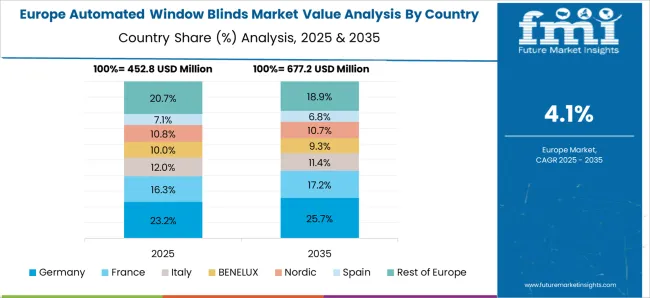
Germany exhibits a 5.2% growth rate, fueled by energy-efficient building trends and smart home integration. High adoption of motorized, IoT-enabled window blinds in residential and commercial properties drives the market. Manufacturers focus on durable materials, automation precision, and customizable designs. Integration with voice assistants, mobile apps, and building management systems enhances convenience. Green building initiatives and energy-saving regulations further support adoption. Export of German-engineered automated blinds strengthens global presence. Rising preference for sustainable and aesthetically pleasing solutions boosts market growth. Contractors and homeowners prioritize systems that improve indoor comfort, energy efficiency, and operational convenience.
The UK market grows at 4.3%, driven by smart home adoption and modern construction projects. Motorized and IoT-integrated blinds gain popularity for energy efficiency and convenience. Manufacturers focus on durable materials, advanced automation, and aesthetic designs. Adoption in residential, commercial, and hospitality sectors fuels market expansion. Rising awareness about energy conservation and indoor comfort strengthens demand. Retrofitting older properties with automated blinds also contributes to market growth. Contractors and homeowners increasingly prefer reliable, easy-to-use systems with remote or voice control. Government energy efficiency initiatives indirectly support smart window solutions.
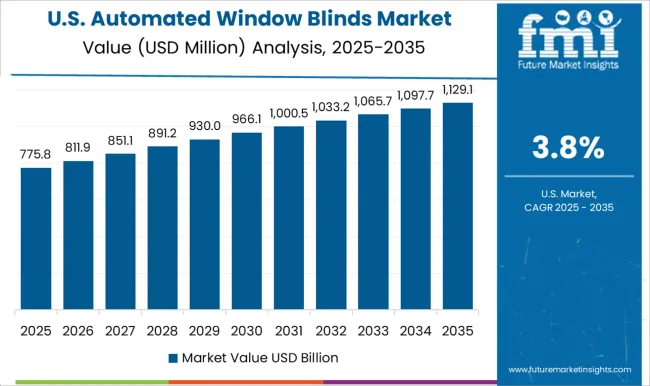
The USA market grows at 3.8%, driven by smart home adoption, energy-efficient building trends, and modern commercial spaces. Motorized blinds with IoT integration and app-based control gain traction in residential and office environments. Manufacturers emphasize durability, automation precision, and aesthetic appeal. Demand for retrofitting older buildings with automated blinds supports growth. Integration with voice assistants, smart thermostats, and home automation systems enhances market adoption. Energy efficiency regulations and incentives for smart homes further boost sales. Consumers prioritize systems that improve comfort, convenience, and operational efficiency. Export of USA-made smart blinds strengthens global market presence.
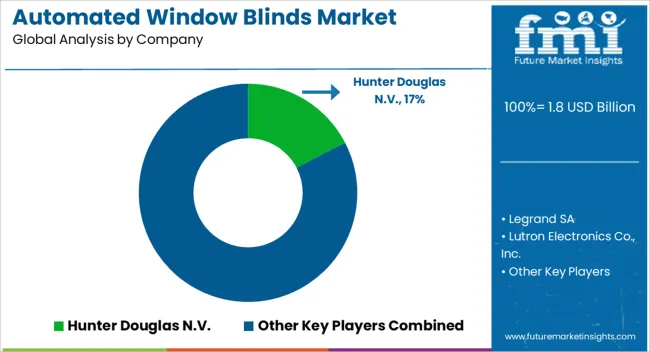
The Automated Window Blinds Market is experiencing robust growth, driven by increasing adoption of smart home technologies, energy-efficient building solutions, and rising consumer preference for convenience and automation. Automated blinds integrate motorized systems with sensors, timers, and smart home platforms, allowing users to control natural light, privacy, and energy consumption seamlessly.
They are widely used in residential, commercial, and hospitality sectors, enhancing comfort while contributing to sustainability goals. Key players shaping this market include Hunter Douglas N.V., renowned for premium motorized and automated blind solutions, and Legrand SA, which offers integrated building automation systems with advanced shading controls. Lutron Electronics Co., Inc. provides smart shading systems with connectivity to lighting and climate control for optimal energy efficiency, while MechoSystems, Inc. focuses on highly customizable and scalable automated shading solutions.
Nien Made Enterprise Co., Ltd., QMotion Incorporated, and Somfy SA provide technologically advanced motorized blinds and controllers compatible with smart home ecosystems. Springs Window Fashions, LLC, The Shade Store LLC, and Warema Renkhoff SE emphasize design flexibility, durability, and integration with energy management systems. The market is witnessing trends such as voice-controlled blinds, solar-powered motorization, and IoT-enabled automation, which improve convenience, safety, and energy savings. As smart building adoption accelerates globally, automated window blinds are becoming a critical component of connected environments.
Growing urbanization, rising disposable income, and emphasis on energy-efficient infrastructure are expected to further boost market demand. Consequently, the automated window blinds market is poised for strong growth as homeowners and businesses increasingly prioritize comfort, sustainability, and seamless technological integration.
| Item | Value |
|---|---|
| Quantitative Units | USD 1.8 Billion |
| Product Type | Horizontal, Vertical, Roman, Roll Up, and Others (PVC, zebra, curtain) |
| Operation | Fully automatic and Semi-automatic |
| Material | Aluminium, Wooden, PVC, and Others (vinyl, metal) |
| Installation | New and Retrofit |
| End Use | Home, Office, Restaurants and hotels, Hospitals & nursing homes, School and university, and Others |
| Distribution Channel | Offline and Online |
| Regions Covered | North America, Europe, Asia-Pacific, Latin America, Middle East & Africa |
| Country Covered | United States, Canada, Germany, France, United Kingdom, China, Japan, India, Brazil, South Africa |
| Key Companies Profiled | Hunter Douglas N.V., Legrand SA, Lutron Electronics Co., Inc., MechoSystems, Inc., Nien Made Enterprise Co., Ltd., QMotion Incorporated, Somfy SA, Springs Window Fashions, LLC, The Shade Store LLC, and Warema Renkhoff SE |
| Additional Attributes | Dollar sales by type including motorized roller blinds, Venetian blinds, and vertical blinds, application across residential, commercial, and hospitality sectors, and region covering North America, Europe, and Asia-Pacific. Growth is driven by rising adoption of smart home technologies, demand for energy-efficient solutions, and increasing focus on convenience and interior aesthetics. |
The global automated window blinds market is estimated to be valued at USD 1.8 billion in 2025.
The market size for the automated window blinds market is projected to reach USD 2.9 billion by 2035.
The automated window blinds market is expected to grow at a 4.5% CAGR between 2025 and 2035.
The key product types in automated window blinds market are horizontal, vertical, roman, roll up and others (pvc, zebra, curtain).
In terms of operation, fully automatic segment to command 61.5% share in the automated window blinds market in 2025.






Our Research Products

The "Full Research Suite" delivers actionable market intel, deep dives on markets or technologies, so clients act faster, cut risk, and unlock growth.

The Leaderboard benchmarks and ranks top vendors, classifying them as Established Leaders, Leading Challengers, or Disruptors & Challengers.

Locates where complements amplify value and substitutes erode it, forecasting net impact by horizon

We deliver granular, decision-grade intel: market sizing, 5-year forecasts, pricing, adoption, usage, revenue, and operational KPIs—plus competitor tracking, regulation, and value chains—across 60 countries broadly.

Spot the shifts before they hit your P&L. We track inflection points, adoption curves, pricing moves, and ecosystem plays to show where demand is heading, why it is changing, and what to do next across high-growth markets and disruptive tech

Real-time reads of user behavior. We track shifting priorities, perceptions of today’s and next-gen services, and provider experience, then pace how fast tech moves from trial to adoption, blending buyer, consumer, and channel inputs with social signals (#WhySwitch, #UX).

Partner with our analyst team to build a custom report designed around your business priorities. From analysing market trends to assessing competitors or crafting bespoke datasets, we tailor insights to your needs.
Supplier Intelligence
Discovery & Profiling
Capacity & Footprint
Performance & Risk
Compliance & Governance
Commercial Readiness
Who Supplies Whom
Scorecards & Shortlists
Playbooks & Docs
Category Intelligence
Definition & Scope
Demand & Use Cases
Cost Drivers
Market Structure
Supply Chain Map
Trade & Policy
Operating Norms
Deliverables
Buyer Intelligence
Account Basics
Spend & Scope
Procurement Model
Vendor Requirements
Terms & Policies
Entry Strategy
Pain Points & Triggers
Outputs
Pricing Analysis
Benchmarks
Trends
Should-Cost
Indexation
Landed Cost
Commercial Terms
Deliverables
Brand Analysis
Positioning & Value Prop
Share & Presence
Customer Evidence
Go-to-Market
Digital & Reputation
Compliance & Trust
KPIs & Gaps
Outputs
Full Research Suite comprises of:
Market outlook & trends analysis
Interviews & case studies
Strategic recommendations
Vendor profiles & capabilities analysis
5-year forecasts
8 regions and 60+ country-level data splits
Market segment data splits
12 months of continuous data updates
DELIVERED AS:
PDF EXCEL ONLINE
Automated Radionuclide Dispenser Market Size and Share Forecast Outlook 2025 to 2035
Automated Tool Grinding Systems Market Size and Share Forecast Outlook 2025 to 2035
Automated Test Equipment Market Size and Share Forecast Outlook 2025 to 2035
Automated Machine Learning Market Forecast Outlook 2025 to 2035
Automated CPR Device Market Size and Share Forecast Outlook 2025 to 2035
Automated Compound Storage and Retrieval (ACSR) Market Size and Share Forecast Outlook 2025 to 2035
Automated People Mover Market Size and Share Forecast Outlook 2025 to 2035
Automated Colony Picking Systems Market Size and Share Forecast Outlook 2025 to 2035
Automated Truck Loading System Market Size and Share Forecast Outlook 2025 to 2035
Automated Microplate Handling Systems Market Size and Share Forecast Outlook 2025 to 2035
Automated Solid Phase Extraction Systems Market Size and Share Forecast Outlook 2025 to 2035
Automated Infrastructure Management Solution Market Size and Share Forecast Outlook 2025 to 2035
Automated Mineralogy Solution Market Size and Share Forecast Outlook 2025 to 2035
Automated Material Handling Equipment Market Size and Share Forecast Outlook 2025 to 2035
Automated Feeding Systems Market Size and Share Forecast Outlook 2025 to 2035
Automated Labeling Machines Market Size and Share Forecast Outlook 2025 to 2035
Automated Solar Panel Cleaning Market Size and Share Forecast Outlook 2025 to 2035
Automated Molecular Diagnostics Testing System Market Size and Share Forecast Outlook 2025 to 2035
Automated Infrastructure Management (AIM) Solutions Market Size and Share Forecast Outlook 2025 to 2035
Automated Cell Culture Systems Market Analysis - Size, Share & Forecast 2025-2035

Thank you!
You will receive an email from our Business Development Manager. Please be sure to check your SPAM/JUNK folder too.
Chat With
MaRIA